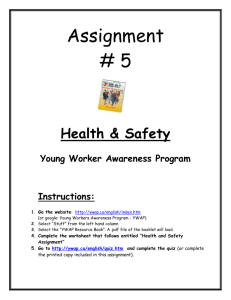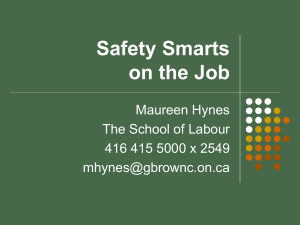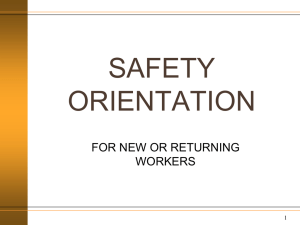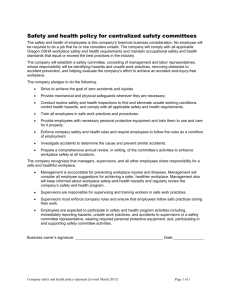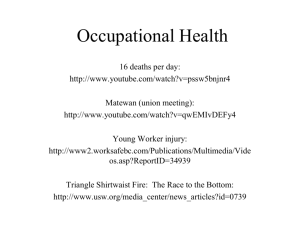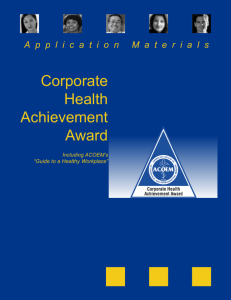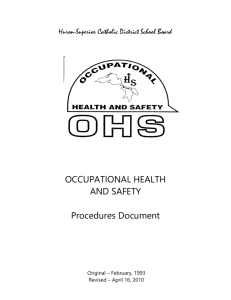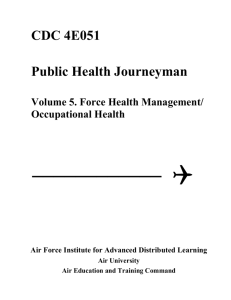-1- YWAP - Work Smart Work Safe CD
advertisement
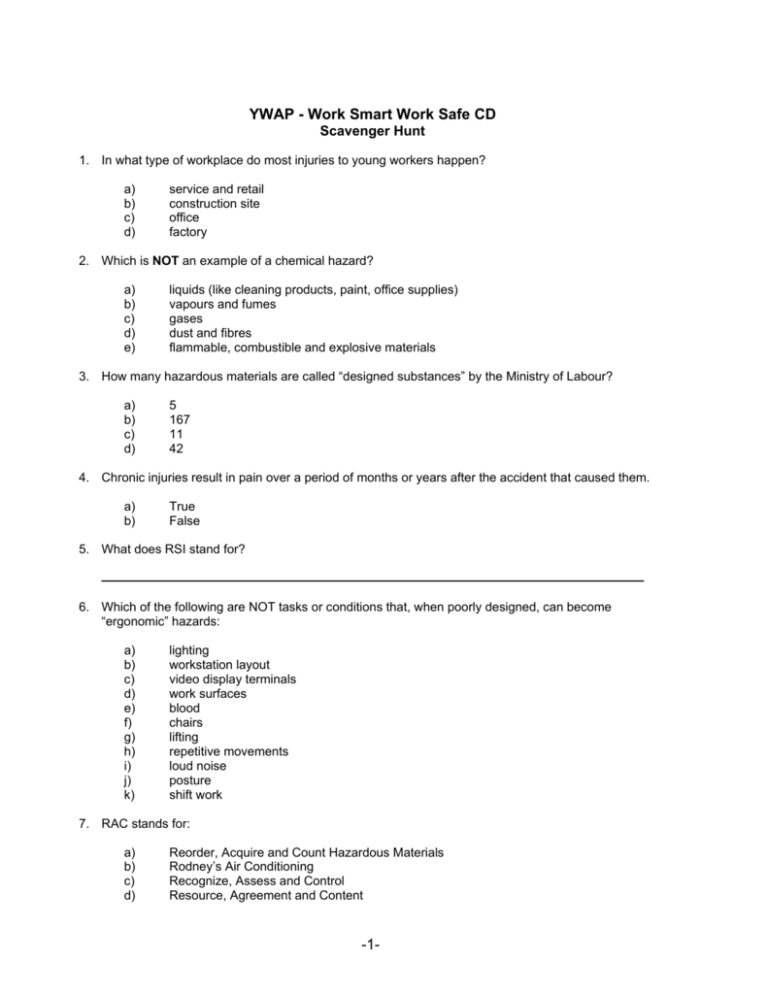
YWAP - Work Smart Work Safe CD Scavenger Hunt 1. In what type of workplace do most injuries to young workers happen? a) b) c) d) service and retail construction site office factory 2. Which is NOT an example of a chemical hazard? a) b) c) d) e) liquids (like cleaning products, paint, office supplies) vapours and fumes gases dust and fibres flammable, combustible and explosive materials 3. How many hazardous materials are called “designed substances” by the Ministry of Labour? a) b) c) d) 5 167 11 42 4. Chronic injuries result in pain over a period of months or years after the accident that caused them. a) b) True False 5. What does RSI stand for? 6. Which of the following are NOT tasks or conditions that, when poorly designed, can become “ergonomic” hazards: a) b) c) d) e) f) g) h) i) j) k) lighting workstation layout video display terminals work surfaces blood chairs lifting repetitive movements loud noise posture shift work 7. RAC stands for: a) b) c) d) Reorder, Acquire and Count Hazardous Materials Rodney’s Air Conditioning Recognize, Assess and Control Resource, Agreement and Content -1- 8. Which is NOT among the 5 most common injuries to young workers? a) b) c) d) e) f) sprains and strains soft tissue injuries bone fractures inflammation of joints hard tissue injuries burns or scalds 9. Which one of the following types of workplaces is NOT under federal (Labour Code) jurisdiction? a) b) c) d) Postal service 407 Highway administration TD Bank CBC television 10. What is Ms. Adams’ profession? a) b) c) d) lawyer supervisor nurse teacher 11. Usually all machines are safe, and most of the time guards get in the way of doing your work properly. a) b) True False 12. Farm workers, domestic servants, and federal workers are not covered by the Occupational Health and Safety Act. a) b) True False 13. If you hurt yourself on the job, what should you do first? a) b) c) d) tell your supervisor get first aid treatment file a claim with the Workplace Safety & Insurance Board (WSIB) call your family and ask someone to come and pick you up 14. Which do NOT present biological hazards? a) b) c) d) e) f) g) h) i) unclean restrooms medical waste your little brother (at his worst!) mould, fungus, mildew bacteria and viruses lighting plants insect bites animal bites -2- 15. In Ontario, about how many young workers suffer injuries at work every day? a) 50 b) 12 c) 149 d) 3 16. If you spot a fire at work what should you do first? a) b) c) d) call 911 pull the fire alarm and call for help run try to put the fire out 17. Which is NOT a physical hazard? a) b) c) d) electricity WHMIS controlled products heat and cold noise and vibration 18. If you are injured at work, a report must be sent to the WSIB by the employer: a) b) c) within three days within three weeks at the end of the month 19. By law, the Occupational Health and Safety Act must be posted in your workplace? a) b) True False 20. During a job interview, some questions that could be asked of the employer are: a) b) c) d) e) f) What company health and safety rules or policies should I know about to do my job safely? What are the hazards in the job? In the workplace? Potential hazards could be noise, chemicals, radiation, and shift work. Are there any Designated Substances in the workplace? What are they? Are the regulations for them posted? Will I get safety training for this job? WHMIS training? When? What should I do if I get injured? Who is the trained first aid person in my work area? all of the above 21. Where do occupational health and safety laws come from? a) b) c) d) Workplace Safety and Insurance Board Industrial Accident Prevention Association Ministry of Labour Canadian Centre for Occupational Health and Safety 22. What door provides information on the Occupational Health and Safety Act? a) b) c) d) 1 2 3 Resource Centre -3- 23. Are people who pick apples on a farm covered by the Occupational Health and Safety Act? a) b) Yes No 24. The purpose of an Internal Responsibility System (IRS) is to: a) b) c) d) e) f) g) give employers sole responsibility to apply occupational health and safety standards within their organization. The IRS allows senior managers to make policies and decisions without the need for employee feedback. require employers to have a health and safety policy and program. give direct responsibility that officers of a company have for health and safety. allow the joint health and safety committee, or, in smaller workplaces, the health and safety representative, to play a role by monitoring the Internal Responsibility System. only b, c, and d all of the above none of the above 25. A worker can refuse to work if he/she has reason to believe that one or more of the following is true: a) b) c) d) e) Any machine, equipment or tool that the worker is using or is told to use is likely to endanger himself or herself or another worker. The physical condition of the workplace or workstation is likely to endanger the worker. Any machine, equipment or tool that the worker is using, or the physical condition of the workplace, is in violation of the Act or regulations and is likely to endanger himself or herself or another worker. all of the above none of the above 26. In the real-life accidents discussed on the CD, what happened to David? a) b) c) d) His right arm was amputated. He was severely burned. He fell down the stairs. His left arm was amputated. 27. How many lockers are there in the hallway? a) b) c) d) e) 6 12 7 8 10 28. All workers have the right to refuse unsafe work. a) b) True False 29. Ministry of Labour inspectors have the power to: a) b) c) d) e) inspect a workplace. investigate potentially hazardous situations and work refusals in a workplace. order compliance with the Act and regulations. recommend prosecution of those who are not in compliance with the Act. all of the above -4- 30. What are some ways in which an employer can prevent injuries from occurring? a) b) c) d) e) label hazardous materials provide proper training conduct their own periodic workplace inspections create and maintain a health and safety committee all of the above 31. Companies can be fined up to __________ for not following the Act. a) b) c) d) $50,000 $500,000 $1,000,000 $1,500,000 32. In WHMIS, Class F is categorized as a dangerously reactive material. a) b) True False 33. Which of the following is not an example of personal protective equipment? a) b) c) d) a car seat belt safety glasses material safety data sheets steel-toed work boots 34. If you have a question or concern while you’re at work, by law, whom should you contact first? a) b) c) d) e) f) supervisor health and safety representative a member of the workplace joint health and safety committee a union representative a health and safety professional any of the above 35. Which teacher instructs the “Rights and Responsibilities” class? a) b) c) d) Mrs. O’Connell Mr. Symonette Ms. Adams Mr. Davidson 36. What’s the 2nd line of the eye examination chart? 37. What is the correct answer to question # 6 on the quiz? Is it: a) True b) False 38. What colour is the little Occupational Health and Safety Act book? -5- 39. The toll free number for the Industrial Accident Prevention Association is 1-800-406-4272. a) b) True False 40. How many videos can be viewed in the “Rights and Responsibilities” class? a) b) c) d) 3 4 5 6 41. The purpose of a joint health and safety committee is to a) b) c) d) e) make sure all health and safety concerns are resolved identify and recommend solutions to health and safety problems conduct monthly inspections of the workplace all of the above none of the above 42. Who was killed in a chemical explosion while on a job? a) b) c) d) e) David Rick Mike Martin Sean What triggered the fatal explosion? a) b) c) mixing other chemicals an electrical spark carelessness on the part of the employee 43. The toll-free number for the Workers Health & Safety Centre is 1-888-869-7950. a) b) True False 44. Your boss is required to train you if you are exposed or likely to be exposed to a hazardous substance. a) b) True False 45. Ms. O’Conner is wearing a watch. a) b) True False 46. Virtually all workplaces with 20 or more employees must have: a) b) c) d) a lunchroom a pool table a joint health and safety committee a parking lot -6- 47. All of the following are physical hazards: • electricity • noise and vibration • hot and cold environments • dust and fibres • radiation • exposed moving parts on machinery a) b) True False 48. Only one of the television sets has something sitting on top of it. What was that object? a) b) c) d) binoculars apple monkey globe 49. How many WHMIS warning symbols are there? a) b) c) d) 8 10 12 14 50. How often must a Material Safety Data Sheet (MSDS) be updated? a) b) c) d) every day every month every year every three years BONUS: 51. What is the name of the high school in the CD? ______________________________________ 52. What is the name of their school team? a) b) c) d) Bulls Rhinos Spartans Hippos -7- YWAP Scavenger Hunt Answers 1. 2. 3. 4. 5. 6. 7. 8. 9. 10. 11. 12. 13. 14. 15. 16. 17. 18. 19. 20. 21. 22. 23. 24. 25. 26. a) d) c) a) Repetitive Strain Injury e) and i) c) e) b) c) b) a) b) f) a) b) b) a) a) f) c) b) b) g) d) a) BONUS! -8- 27. 28. 29. 30. 31. 32. 33. 34. 35. 36. 37. 38. 39. 40. 41. 42. 43. 44. 45. 46. 47. 48. 49. 50. 51. 52. d) b) e) e) b) a) c) a) b) CKZDV8 b) green a) b) d) e); second part b) a) a) a) c) a) b) a) d) West Park High Rhinos
